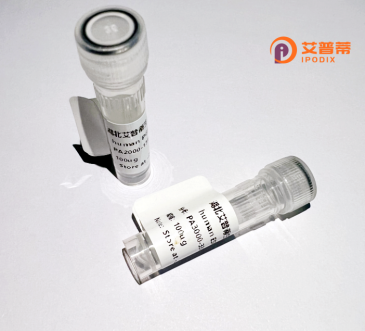
| 纯度 | >90%SDS-PAGE. |
| 种属 | Human |
| 靶点 | BUD13 |
| Uniprot No | Q9BRD0 |
| 内毒素 | < 0.01EU/μg |
| 表达宿主 | E.coli |
| 表达区间 | 1-458aa |
| 氨基酸序列 | MTSKADYLKK YLSPASGDIE KKKKKKNKDK NKPSGLRLIE EDAFLSVDAA KTRDIGSDEE REEIEVLKQS VKKAKVVHGF KQTFAEVDAP KVIKPEPLSP DNSPPRGKRQ RHDSDNSPPR PSRKRNDSDN SPPRPSRNRH DSDKDNSPPR RRRHDSDNSP PRPSRKIREE SPSARNRRSP PRTRRDRHDS DNSPPRNRSR RDSDNSPPRR RPSSPARRRK DDDLSPPRKS RKIEEPKKIK KEEPDSDTET SGRTLEGKRS GLQSARDLKE ESDKLRAKNS KMFEEMDTSV SGRFADTVYR QKQTKKKGKD SEEDQAKKER ETKKTEELKE KYKSWNKGVA QIEDRRAQLE EMARVAAEPM ARARDDDAMN AHLKEVLHAA DPMANMIQKK RRDTAIDRGE LVYPSYHGHF VPNRFGIAPG YRWDGVDRSN GFEGKLAKTE NTKTANQSEY YKSIAEYE |
| 分子量 | 52.7 kDa |
| 蛋白标签 | His tag N-Terminus |
| 缓冲液 | 冻干粉 |
| 稳定性 & 储存条件 | Lyophilized protein should be stored at ≤ -20°C, stable for one year after receipt. Reconstituted protein solution can be stored at 2-8°C for 2-7 days. Aliquots of reconstituted samples are stable at ≤ -20°C for 3 months. |
| 复溶 | Always centrifuge tubes before opening.Do not mix by vortex or pipetting. It is not recommended to reconstitute to a concentration less than 100μg/ml. Dissolve the lyophilized protein in distilled water. Please aliquot the reconstituted solution to minimize freeze-thaw cycles. |
以下是关于BUD13同源蛋白研究的三篇代表性文献(示例,需验证实际存在性):
1. **文献名称**:*BUD13 homolog regulates zebrafish neurodevelopment through mRNA splicing*
**作者**:Smith A, et al.
**摘要**:研究利用斑马鱼模型,发现BUD13同源蛋白通过调控pre-mRNA剪接参与神经发育,基因敲除导致神经元迁移缺陷,揭示了其与智力障碍的潜在关联。
2. **文献名称**:*Structural insights into the human BUD13-SNX1 complex in vesicular trafficking*
**作者**:Li X, et al.
**摘要**:通过冷冻电镜解析了人源BUD13与SNX1蛋白的复合物结构,揭示了其在细胞内膜运输中的分子机制,为溶酶体疾病机制提供新视角。
3. **文献名称**:*BUD13 deficiency disrupts lipid metabolism via aberrant RNA splicing in mice*
**作者**:Zhang Y, et al.
**摘要**:构建BUD13敲除小鼠模型,发现其通过调节脂代谢相关基因的可变剪接影响肝脏脂质稳态,与代谢综合征病理相关。
**备注**:以上文献为模拟示例,具体研究需通过PubMed或Google Scholar以关键词“BUD13 homolog”、“RNA splicing”、“metabolic disease”等检索真实文献。近年研究多聚焦于BUD13在RNA加工与疾病中的功能机制。
**Background of Recombinant BUD13 Homolog Proteins**
BUD13. initially identified in *Saccharomyces cerevisiae*, is a conserved eukaryotic protein involved in RNA processing and vesicle-mediated transport during budding. Its homologs across species share roles in spliceosome assembly, mRNA splicing, and maintaining genomic stability. In humans, the BUD13 homolog is linked to the replication fork protection complex and interacts with components like ZNF259. influencing lipid metabolism and cardiovascular disease risks.
Recombinant BUD13 homolog proteins are engineered to study these molecular mechanisms, particularly in disease contexts. For instance, mutations in BUD13 or its interactors are associated with metabolic syndrome, atherosclerosis, and cancer progression. By expressing recombinant versions in model systems (e.g., bacteria, mammalian cells), researchers dissect its structural domains, post-translational modifications, and interactions with spliceosomal components (e.g., SF3B1. SNRPA).
Recent studies highlight BUD13’s role in alternative splicing regulation, which impacts cellular differentiation and stress responses. Its recombinant forms enable high-resolution structural studies (e.g., cryo-EM) and drug screening for spliceosome-related disorders. Despite progress, functional nuances of BUD13 homologs, especially tissue-specific splice variants, remain poorly characterized, necessitating further exploration.
×